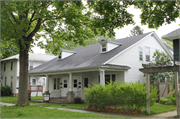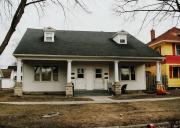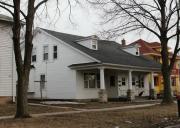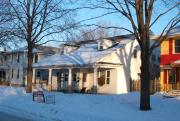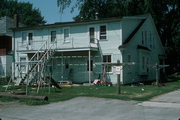| Additional Information: | City of Green Bay, Wisconsin - Architectural and Historical Intensive Survey Report Phase 1 - 2021
A 'site file' exists for this property. It contains additional information such as correspondence, newspaper clippings, or historical information. It is a public record and may be viewed in person at the Wisconsin Historical Society, State Historic Preservation Office.
Photo code #2: 75BR-7/7,8
Large side gabled house with an open, full width front porch under the slope of the main eaves. The porch roof is upheld by four Tuscan Order wood columns resting on raised cut stone pedestals. The porch roof covers the rectilinear entrance vestibule which has two entrance door serving the parartments within. This vestibule is probably a later addition, as are the two three window groups which flank it. The floor of the front porch is concrete, and is a later alteration, and is flush with the land. This later characteristic is shared by very few west Green Bay houses and seems to donate an early construction date.
Two thin, glable roof, pedimented dormers face the front and are original to the house. The main gable ends have returned eaves.
The shed roof dormer across the width of the rear roof and the hip roof rectilinear oriel window on the north facing facade are both later additions.
Architectural Engineering Significance
This building is reported to be the last remnant of the post-colonial period Fort Howard still extant on its original site and as such, it has considerable historic as well as architectural significance.
The photo collections of the Wisconsin State Historical Society confirm that the building, which is unique to West Green Bay in style, is in fact, a remnant of Fort Howard.
Historical Background
The house at 412-414 N. Maple Avenue is undoubtedly one of the buildings of the Fort Howard military installation which operated from 1816 to 1852 as an active fort, and then mothballed from 1852 until its sale to the Chicago and North Western Railway Company in 1863.
The fort itself was commissioned as a United Staes installation in 1816 following British evacuation. The British fort was built of logs, as were the buildings within the compound. In 1831, new frame buildings began to be constructed by the troops and some 13 were completed by 1835. It is this group of buildings from which the house at 412-414 Maple comes.(B)
The question is then raised as to which of these buildings 412-414 is. Common wisdom has declared this to be the surgeon's quarters for the Fort and this building was used as the model for the recreation of Heritage Hill. However, discussions with the staff historian raise some doubts as to that claim. The title of Surgeon's quarters was a convenient one due to the proximity (approximately two blocks) of the old Fort Howard Hospital Building prior to its move to Heritage Hill. In face, a 1935 newspaper photo refers to the building as an Officers' Quarters Building, and Historian James Hayward of Heritage Hill tends to agree due to the architectural characteristics of the building (c).
Primary document searches do not provide a definite answer other than the surety that the building is from the Fort Howard group.
Historical Significance
The building at 312-414 N. Maple Avenue is considered significant as the west building on the west side which can be definitely traced to the fort Howard group of structures. Although it has been moved (as were all the buildings connected with the Fort), it has remained in the immediate vicinity of its construction site. By the same token, although the house had had some exterior renovation such as a dormer on the rear, a side oriel window and front entryway, the distrinctive style of the Fort Howard group remains intact immediately identifying this house as part of that group.
#650: Garage.
The Fort Howard Surgeon’s Quarters, presently located at 412 North Maple Avenue, was likely constructed along with the rest of Fort Howard. Non-extant Fort Howard was built on the site of the previous French Fort La Baye and renamed British Fort Edward Augustus. When the United States Army arrived at what is now Green Bay in 1816, they erected the small fort to oversee trade and movement at the mouth of the Fox River. In 1831, new frame buildings were constructed at Fort Howard to replace the older log ones. Approximately thirteen such buildings were constructed between 1831 and 1835 for the fort. The Surgeon’s Quarter’s was likely among these. The fort remained a military installation until 1852 when it was mothballed. The property was eventually sold to the Chicago and Northwestern Railroad in 1863. Following the end of the Civil War, the remaining buildings of the fort were moved by railway, which converted the site into railway stations and yards. The Surgeon’s Quarters building was relocated in the late 1860s to a lot a few blocks away from the fort site. The building has been primarily used as a duplex and apartments for the last 150 years.
The building is a republican period Greek Revival style house with a shed dormer roof and simple colonnade. It appears likely that the foundation, siding, openings, and even interior layout have changed since its original construction. The exact original function of the building is in doubt since it could easily have served as officer’s quarters or similar use; however, the building certainly originated with the Fort Howard instillation.
All the extant buildings related to Fort Howard were moved from their original locations onto lots in the surrounding neighborhoods on the west side of Green Bay. Typically, remaining near the original fort site. It is possible that the Chicago and Northwestern Railroad when it acquired the land of the former fort, rolled the existing buildings onto empty adjacent lots from 1868 to 1871. People then purchased them and moved them to their preferred locations. Several of the remaining buildings of Fort Howard were moved to Heritage Hill State Park in the neighboring Village of Allouez in 1975. These remnant buildings are listed on the National Register of Historic Places despite being moved from their original locations. The Fort Howard Surgeon's Quarters is the last remaining Fort Howard building that remains at its second, or possibly third, site.
The Fort Howard Surgeon's Quarters building is significant under Criterion D: as a likely source of important information regarding the construction methods and daily life at Fort Howard from 1831 to the 1850s. The period of significance for the property would extend from 1831 to 1852 when the fort was shuttered.
|
|---|
| Bibliographic References: | Wisconsin Magazine of History, v. 4, 1920-1921, p.272.
Wisconsin Magazine of History, v. 18, #2, Dec. 1934, p. 125. |
|---|

